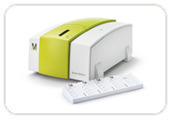
Merck Millipore has launched its Direct Detect biomolecular quantitation system which it believes offers significant advantages over Lowry and Bradford assays
The Direct Detect system exploits Merck Millipore's membrane experience to enable infrared-based measurement of amide bonds in protein chains, an intrinsic component of every protein, without relying on amino acid composition, dye-binding properties, or redox potential.
Conventional assays based on UV-Vis spectroscopy rely on absorbance by a protein's aromatic amino acids and therefore have limited utility.
"After samples are spotted on assay cards, they can be stored in ambient conditions without appreciable change in readout," described John Sweeney, Head of Life Science Business Field, Merck Millipore.
"Another important advantage over conventional assays is that the Direct Detect calibration standard curve requires generation once, which provides additional time savings and ease of use." The system employs a hydrophilic polytetrafluoroethylene (PTFE) membrane designed to be transparent in most of the infrared spectral region and enables application of biomolecule solutions directly onto the membrane.
It claims to delivers more universally applicable and faster protein quantitation, requiring minimal sample consumption.
System accuracy and precision are thought to be comparable with results obtained by amino acid analysis, an accurate standard for quantitation, yet can be time-consuming and often costly.
Because the system relies on IR-based detection of biomolecules, users can obtain accurate and reproducible protein quantitation in presence of reducing agents and detergents.
As a result, the Direct Detect system can measure protein concentrations from 0.2 mg/mL to 5 mg/mL within seconds, without any bio- or immunochemical staining, directly from samples, including buffered solutions.
The Direct Detect system can also be used to provide information on non-protein sample components, such as lipids and nucleic acids.





